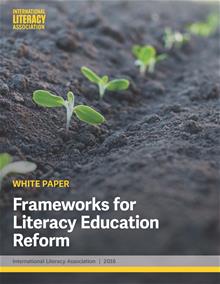ILA developed Frameworks for Literacy Education Reform in response to today’s complex and evolving education landscape. With an increase in English learners, high-stakes testing, and digital technologies driving new modes of teaching and learning, challenges for the classroom teacher are mounting. The new white paper’s frameworks serve as a high-level rubric that school administrators and policymakers can use to create or assess reform proposals. In this blog series, we’ll take a closer look at each of the frameworks.
 When all is said and done, education is about student success. Building the best schools, preparing teachers for a 21st-century classroom, and investing in education reform will mean nothing if we aren’t focused on the students who cross the threshold every day.
When all is said and done, education is about student success. Building the best schools, preparing teachers for a 21st-century classroom, and investing in education reform will mean nothing if we aren’t focused on the students who cross the threshold every day.
Adding to the educational system’s shortcomings, about 20% of children live in poverty in the United States. This rampant poverty—and near-poverty—puts students at a further educational disadvantage when it comes to both technology access and early language and literacy acquisition. For many, the achievement gap starts even before a child gets to the first day of school.
“This was not a difficult section for our subgroup to write,” said Doris Walker-Dalhouse, a lead writer on the student support framework of the Frameworks for Literacy Education Reform and professor of literacy at Marquette University in Wisconsin. “We wanted to focus on the aspects of students' lives outside of the classroom that impact their engagement in learning within school settings and influence their long-term growth and development as citizens in a democratic society.”
For example, many families don’t have computers, tablets, and mobile devices in the home, nor do they have access to the Internet in the neighborhoods and communities. This technology gap further compromises students’ exposure to new literacy education experiences and hinders their preparation to thrive as adults in an increasingly digital society.
At school, students also need to grow every year to perform at or above grade-level literacy standards. Effective teachers can help this growth happen. When students are not performing at grade level, curriculum and instruction must be adjusted, whether through extended day, week, or year programs, or by using additional measures that include students’ social and emotional growth as a guide to the best practice in individual instruction.
“I believe that while it is a challenging framework,” said Walker-Dalhouse, “teachers and schools that focus on educational equity for their students will seek opportunities to change their practices and advocate for resources and programs that will improve educational outcomes and social-economic conditions for the children, communities, and families that they serve.”
The complete white paper, Frameworks for Literacy Education Reform, can be found here.
April Hall is editor of Literacy Daily. A journalist for 20 years, she has specialized in education, writing and editing for newspapers, websites, and magazines.